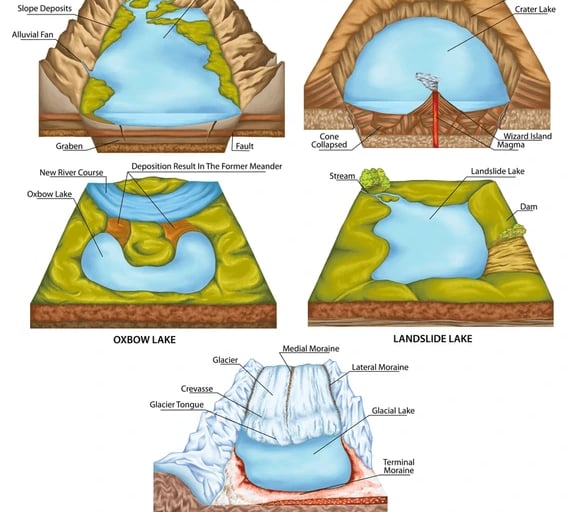The Formation and Importance of Oxbow Lakes: Nature's Crescent-Shaped Wonders
Oxbow lakes are crescent-shaped bodies of water formed when a river's meandering curve is cut off from the main flow. Created by erosion and deposition, these lakes offer vital habitats for wildlife and support aquaculture. They also trap sediments and pollutants, contributing to river health, though they are vulnerable to drying up and pollution
GEOVISTA

Oxbow lake: The work of a river
What is an Oxbow Lake?
An oxbow lake is a crescent-shaped body of still water that forms alongside a winding river. Once part of the river’s meandering course, it becomes separated and forms a standalone lake when a meander is cut off from the main river. These lakes are named after their distinct curved shape, resembling the bow-shaped yoke used on oxen.
How Oxbow Lakes Form
Oxbow lakes are formed through a process of erosion and deposition that gradually alters the course of a river. Here’s how it happens:
Meandering River: As rivers flow, they often follow a winding path due to the erosion of their outer banks and the deposition of sediments on their inner banks. This process creates a series of curves, or meanders.
Widening Meanders: Water flows faster along the outer edge of the meander, eroding the bank, while slower water on the inner edge deposits sediments. Over time, this causes the meander to become more pronounced.
Neck Cutoff: Eventually, the river erodes the narrow neck of the meander, creating a more direct route for the river. The river then follows this new, straighter course.
Formation of the Oxbow Lake: Deposition of sediments seals off the old meander, isolating it from the main river channel. This creates an oxbow lake, a quiet body of water separated from the river’s flow.
Oxbow Lakes and Their Role in Ecosystems
Oxbow lakes are important features in river ecosystems and play a variety of roles:
Wildlife Habitats: Oxbow lakes often become rich habitats for a variety of wildlife, providing a home for fish, birds, and other aquatic species. Over time, some oxbow lakes turn into swamps or bogs, further enriching the biodiversity of the area.
Aquaculture Potential: Due to their still waters, oxbow lakes can be suitable locations for aquaculture, supporting the farming of fish and other aquatic organisms.
Sediment Trapping: Oxbow lakes help improve the health of river ecosystems by trapping sediments and agricultural runoff. This prevents harmful materials from entering the main river flow, although this sediment buildup can be detrimental to the lake itself.
Challenges Facing Oxbow Lakes
Despite their benefits, oxbow lakes face several challenges:
Drying Up: Without a continuous source of water, oxbow lakes often dry up over time as water evaporates, particularly in arid regions. This natural process can lead to the lake becoming a swamp or disappearing entirely.
Pollution Vulnerability: Oxbow lakes are particularly vulnerable to contamination from agricultural runoff and industrial pollutants, including heavy metals. These pollutants can severely damage the delicate ecosystems within the lakes.
Conclusion
Oxbow lakes are fascinating, crescent-shaped formations that arise from the dynamic forces of erosion and deposition in rivers. While they provide important habitats for wildlife and contribute to river health by trapping pollutants, they also face environmental challenges. Understanding their formation and significance helps highlight the intricate ways in which water shapes the natural world.
Subhalakshmi Buragohain
Hyderabad


Oxbow lake: Formation
(Courtesy: Shutterstock)
